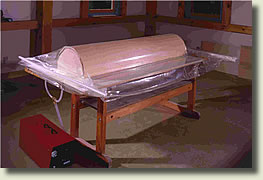Building a Tile-Topped Table
Basic tips for a tile table-top. January 27, 2008
Question
I've just been asked to do a tiled top table with a solid hardwood frame. Overall size is about 32 wide x 48 long. My first thought was a plywood top for tile, then a piece of 6/4 cherry to frame it out and cover edge of ply.
Will I need to cover bottom of ply to avoid moisture problem? Will a few coats of poly do the job? If corners of frame are mitered, what's the best way to keep from opening in climate change? Is it easier to control with a butt joint (scribed in)?
Forum Responses
(Furniture Making Forum)
From contributor B:
My tile top coffee table is built on a layer of exterior plywood. I don't recall if it was 1/2" or 3/4", but it was standard exterior grade fir plywood. The tile adhesive was applied directly to the plywood.
The edge is banded with 1" thick x 2" wide (adding 4" to the width and length of the table) red oak with mitered corners. I was just noticing yesterday that one of the corners is open on the outside (sort of strange, as winter heat related shrinkage should have opened the joint on the inside). However, the table is about 10 years old and I think I've noticed this open joint before.
The only other guidance I'd give is to only put grout between the tiles. If you grout between the tiles and wood border, seasonal wood movement will likely break it up.
From the original questioner:
Thanks. That was my idea on how to make it, just needed some input. Border will lay over ply about 3-4" with bullnose front edge. Any suggestions on how to attach it (screws through OS holes in ply?)?
From contributor B:
Are you going to rabbet the band to hide the plywood edge? I think screwing up through the plywood into the overlapped band would be fine along with biscuit wafering the miters. A butt jointed corner might be a better idea, though, with 3" to 4" wide banding.
From contributor G:
We have done lots of different style tables with tile tops. We found using a 3/4 cab grade ply, 3 coats of sealer each side, with a 1/4 Durock board on the tile side, works really well. We also try to use a sanded caulk the same color as the grout between the wood edging and the tile; works like an expansion joint.
From the original questioner:
Thanks! Some great ideas. If I use pre-finished cabinet grade ply, can I just scuff surface with 100 grit? Will the tile adhesive work? Contributor G, you use a different product (sanded caulk) than grout... Does it stay wet and expandable?
From contributor G:
The sanded caulk does harden, but retains enough elasticity to allow movement between the solid edging and the tile. The tile adhesive will bond the tile to the ply but will probably fail over time, especially if the table is moved often.
